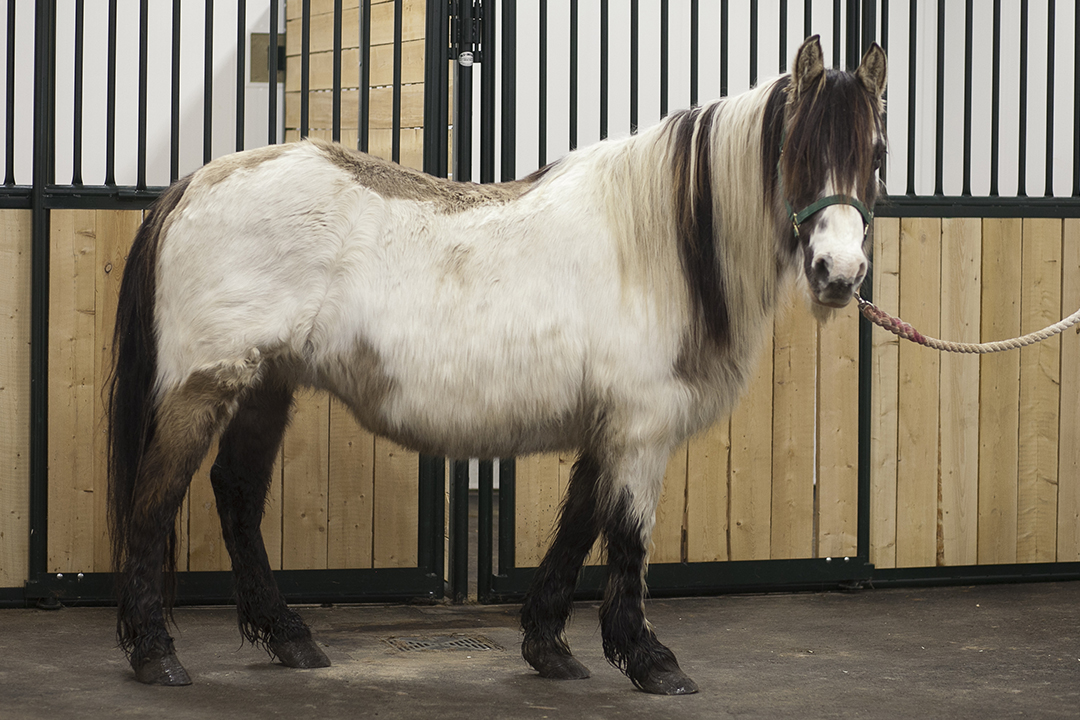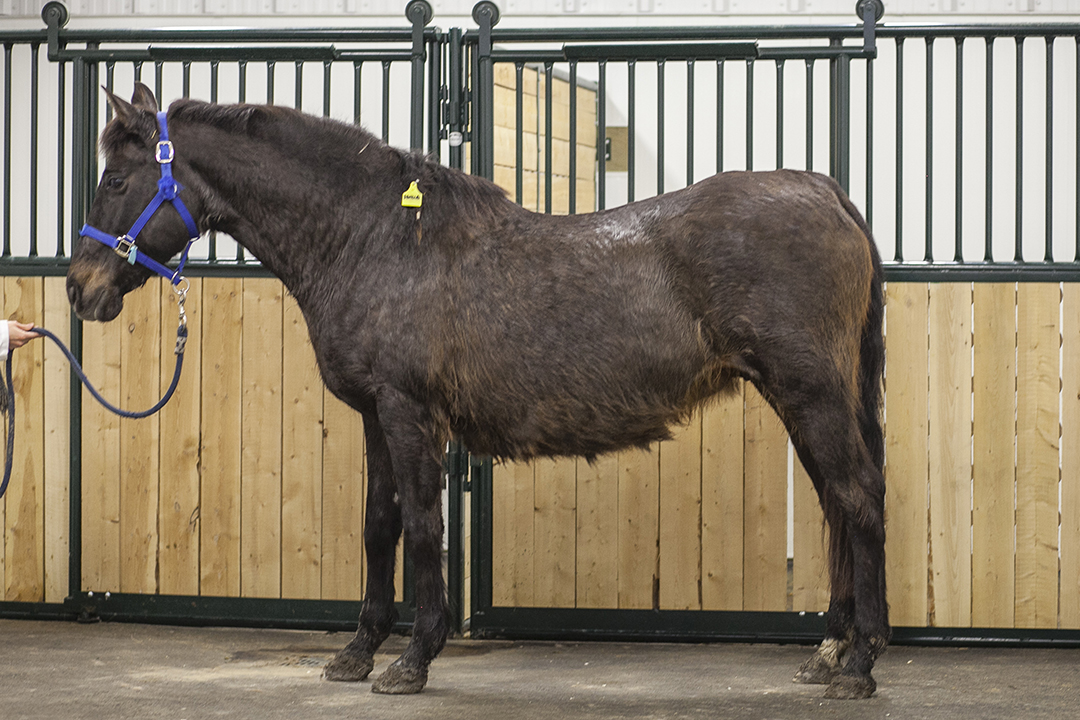General information

Pituitary pars intermedia dysfunction (or equine Cushing’s disease) is a complex health problem that leaves many horse owners confused. After receiving the diagnosis from your veterinarian, you may be wondering what you can do to improve your horse's quality of life. Fortunately, the prognosis for PPID is good in most cases; many horses can live long and healthy lives with proper management.
While the horse industry has traditionally described this disease as equine Cushing's, the name is misleading: the syndrome that we see in horses is different than Cushing's disease in humans and dogs, both in the clinical signs and the disease process. For this reason, veterinarians now describe the syndrome as pituitary pars intermedia dysfunction (PPID).
What causes PPID?
PPID is an endocrine disease or a disorder of the hormone system. Hormones are chemicals produced by the body that regulate cell and organ function. Most of the body’s hormones are controlled by the pituitary gland, a small gland in the brain that’s divided into three parts: pars distalis, pars intermedia, and pars nervosa.
In a normal horse, nerves releasing a neurotransmitter called dopamine inhibit the function of the pars intermedia portion of the pituitary gland to maintain the appropriate level of hormone production. In a horse diagnosed with PPID, this process doesn’t occur and the result is an overly active and enlarged pars intermedia. The symptoms of PPID occur because the pars intermedia produces excess amounts of adrenocorticotropic hormone (ACTH).
Since the pars intermedia doesn’t usually produce most of the body's ACTH, it doesn’t respond well to negative feedback mechanisms that tell the equine brain that there is too much ACTH circulating in the body. That’s why the pars intermedia of the pituitary of a PPID-affected horse will continue to produce ACTH despite high levels of the hormone.
What causes the pars intermedia to stop working properly? No one knows for certain, but it may be that as horses age, oxidative damage to neurons accumulates until there is a defect in dopamine transmission. If we compare PPID to human diseases, it is similar to Parkinson's disease where there is also a loss of inhibition by dopamine.
What are the clinical signs?
PPID typically affects horses about 15 years of age and older, and clinical signs tend to progressively worsen as the horse ages. While there is no breed predisposition, ponies and other horses that tend to live longer are more often affected by the disease.
The most common and unique clinical sign of PPID in a horse is a continuously long hair coat that doesn’t shed in the spring (hirsutism or hypertrichosis). Affected horses also tend to sweat excessively.
Laminitis is also common in PPID-affected horses and this devastating, painful disease is what ultimately limits the horse's life. Laminitis is inflammation within the hoof wall and is more commonly seen in the front feet. Affected horses are often unwilling to move and stand rocking backwards to shift their weight to the hind feet.
Other clinical signs of PPID that may be present include a pot-bellied appearance, weight loss, muscle wasting and lethargy. Affected horses may also be more susceptible to infection.
What should I do?
Diagnosis
If you suspect that your horse may have PPID, contact your veterinarian. While PPID’s relatively unique clinical signs can lead veterinarians to suspect the disease, they can definitively diagnose it using several laboratory tests.
Baseline ACTH: The first step in diagnosing PPID is a blood test is to measure baseline ACTH. A horse with PPID will have ACTH levels that are higher than normal.
In a horse with obvious clinical signs, results from this test are usually enough for a veterinarian to make a diagnosis of PPID. However, it may be less conclusive in horses with few symptoms. In these cases, a veterinarian can repeat the test in six months or use an additional test, such as the dexamethasone suppression test, to make a diagnosis.
Horses’ ACTH levels vary seasonally with the highest levels occurring in the fall. That’s why veterinarians avoid testing during this season since it can result in a false positive test for PPID in a normal horse.
Thyrotropin releasing hormone stimulation test: A thyrotropin releasing hormone (TRH) stimulation test used to be more commonly used to diagnose PPID, but because it can be difficult for veterinarians to access TRH, the test isn’t usually performed.
In another effort to help horse owners, the WCVM Veterinary Medical Centre’s pharmacy now offers the TRH stimulation test, a dynamic test used to diagnose PPID. However, this particular test is only available for use by WCVM clinicians since it contains products compounded in the college’s pharmacy.
Treatment and management

While PPID can’t be cured, it’s possible for a dedicated owner to manage the disease with daily doses of a drug called pergolide (Prascend) that human physicians originally used to treat Parkinson's disease in their patients. Pergolide acts like dopamine to inhibit the pars intermedia in the pituitary gland, and this inhibition prevents excess production of ACTH.
Veterinarians usually begin with a low dose of the drug and then increase the daily dosage until the symptoms are well controlled in the affected horse. During the course of the disease, the dose may have to be adjusted.
Horse owners typically see an improvement in the horse’s clinical signs after six to eight weeks of treatment. A veterinarian can repeat the diagnostic tests to determine if hormone production has returned to normal, and it’s recommended that horses should be assessed every six months.
While most horses don’t experience any side effects from the pergolide treatments, some horses will become lethargic or go off feed for a few days. In rare cases, horses may develop diarrhea or colic. It may be necessary to reduce the peroglide dosage; your veterinarian will work with you to determine a dose that controls your horse's clinical signs and is tolerated well.
One of the most important reasons for starting drug therapy or increasing the dose of pergolide is the potential risk of laminitis or recurring episodes of the disease. While veterinarians still don’t fully understand the link between laminitis and PPID, they do know that horses diagnosed with PPID are at a higher risk of laminitis — the clinical sign that most often limits their lives.
Researchers now believe that the development of laminitis is more likely a result of equine metabolic syndrome (EMS) and that horses with PPID and laminitis may have EMS concurrently. In other words, a horse can have both disorders at the same time.
It’s important to be aware of the clinical signs of laminitis such as soreness in the front feet, an unwillingness to move, a rocking backwards posture, or an exaggerated lifting of the front feet while walking. Talk to your veterinarian if you have any concerns.
Some changes in management can also help to make your horse more comfortable. Since affected horses often have a longer hair coat, you can clip its coat during the summer months. As well, ensure your horse receives regular veterinary and farrier visits and is up to date on vaccines and deworming.
There is no way to prevent the development of PPID: treatment will alleviate the clinical signs, but it will not stop the disease’s progression. Affected horses may need a higher daily dose of pergolide if clinical signs worsen, and at some point, it can become more difficult to control related issues or your horse may become resistant to treatment. However, many horses can live normal lives for a long time after being diagnosed with PPID.
New research
There are still many questions to be answered about PPID in horses, and the veterinary community is attempting to tackle them. Some areas of research include investigating the connection between PPID and laminitis as well as PPID and EMS. Researchers are also looking at more accurate ways to diagnose and treat PPID.
What’s important to remember is that the diagnosis of PPID is not a death sentence for a horse. With proper management and medical treatment, PPID-affected horses can enjoy long, healthy lives.
Dr. Julia Montgomery is an associate professor at the Western College of Veterinary Medicine (WCVM) and a board-certified specialist of large animal internal medicine in the WCVM’s Veterinary Medical Centre.
EquineED Talk
As part of the WCVM's EquineED Talks series for the horse community, WCVM associate professor Dr. Julia Montgomery gave the following presentation on equine metabolic syndrome (EMS) and pituitary pars intermedia dysfunction (PPID).
News
Horse Health | WCVM
Stories related to PPID
- Hormone baselines for horses in the West
- Surgical solution for PPID?
- Team explores radical therapy for Cushing's disease (PPID)
Loading...

